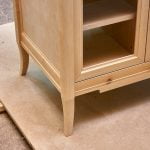Cabinet making has always been considered the cornerstone of woodworking, and for good reason. The skills, techniques, and precision required for cabinet making are fundamental to all other woodworking projects. In this article, we will explore the history of cabinet making, the importance of these skills, and how they impact other areas of woodworking.
The art of crafting cabinets dates back centuries, with evidence of intricate woodwork found in ancient Egyptian tombs. As civilizations evolved, so did the techniques and styles of cabinet making. From traditional hand-crafted methods to modern industrial production, the history of cabinet making showcases the timeless appeal and practicality of this craft.
The significance of cabinet making skills cannot be overstated. The precision and attention to detail required in creating cabinets are essential in mastering other woodworking endeavors. Whether it’s constructing furniture, building structures, or crafting decorative pieces, the foundational knowledge gained from cabinet making lays the groundwork for success in woodworking. In the following sections, we will delve into how cabinet making techniques influence and shape various aspects of woodworking projects.
The Importance of Cabinet Making Skills
Cabinet making is an essential skill in the world of woodworking, with a rich history and a significant impact on various other woodworking projects. Here are some key reasons why cabinet making is considered the key to all woodworking:
- Precision and Detail: Cabinet making requires a high level of precision and attention to detail. This skill directly translates to other woodworking projects, ensuring that woodworkers develop a keen eye for accuracy and quality in their craft.
- Versatility of Techniques: Cabinet making encompasses a wide range of techniques, from joinery to carving to finishing. Woodworkers who master cabinet making skills gain a versatile set of abilities that can be applied to diverse woodworking projects, such as furniture-making, cabinetry, and decorative woodwork.
- Impact on Other Woodworking Projects: The foundational skills learned in cabinet making directly impact the success of other woodworking projects. Understanding how to measure accurately, cut cleanly, and assemble pieces effectively are all fundamental aspects of cabinet making that carry over into various other areas of woodworking.
Cabinet Making as the Foundation of Woodworking
Cabinet making is often seen as the foundation of all woodworking, providing essential skills and techniques that serve as the building blocks for a wide range of projects. Whether you are interested in creating furniture, decorative items, or even larger structural elements, mastering cabinet making skills is crucial to achieving success in the woodworking industry.
Here are some key reasons why cabinet making is considered the key to all woodworking:
- Understanding Joinery Techniques: Cabinet making teaches woodworkers how to create strong and durable joints, such as dovetail joints, mortise and tenon joints, and tongue and groove joints. These joinery techniques are fundamental to creating sturdy structures and ensuring the longevity of woodworking projects.
- Developing Precision and Attention to Detail: Cabinet making demands a high level of precision and attention to detail. Woodworkers learn how to measure accurately, cut precisely, and assemble components with meticulous care. These skills are transferable to other woodworking projects, where accurate measurements and precise cuts are equally important.
- Mastering Finishing Techniques: In cabinet making, woodworkers learn various finishing techniques that enhance the beauty and longevity of their creations. This includes staining, varnishing, lacquering, and polishing. The ability to finish a project effectively can elevate the overall quality of any woodworking endeavor.
By mastering the foundational skills taught in cabinet making, woodworkers can confidently take on diverse projects across the woodworking industry with skill and precision. Whether it’s crafting intricate furniture pieces or constructing structural elements for architectural purposes, the principles learned in cabinet making remain essential for success in any woodworking venture.
Precision and Detail in Cabinet Making
The Art of Precision
Cabinet making is often considered the pinnacle of woodworking because of the precision and detail involved in the process. From measuring and cutting to joining and finishing, every step requires meticulous attention to detail. The ability to create precise, seamless joints and perfectly fitted components is a hallmark of skilled cabinet makers. This level of precision not only enhances the functionality of the final product but also elevates its aesthetic appeal.
Attention to Detail
One of the reasons why cabinet making is seen as the key to all woodworking is the emphasis on attention to detail. Every aspect of a cabinet, from the hardware used to the decorative elements, requires careful consideration. The mastery of woodworking techniques such as veneering, inlay work, and intricate joinery sets cabinet making apart as an essential skill for any woodworker. The ability to seamlessly blend form and function through attention to detail is what distinguishes exceptional woodworking craftsmanship.
The Intersection of Precision and Design
Cabinet making not only demands precision in execution but also offers an opportunity for creative expression through detailed design work. The marriage of precision and design in cabinet making is what makes it fundamental to all woodworking endeavors.
Whether creating traditional cabinets or modern pieces, the fusion of precision craftsmanship with innovative design concepts is a hallmark of successful cabinet makers. In this way, cabinet making serves as a bridge between technical skill and artistic vision within the broader spectrum of woodworking.
The Versatility of Cabinet Making Techniques
Woodworking is an intricate and meticulous craft that requires skill, precision, and dedication. It is a time-honored tradition that has been passed down through generations, evolving with the development of new tools and techniques. Cabinet making stands as a cornerstone in the realm of woodworking due to its versatility, complexity, and significance in the production of furniture and woodwork.
Cabinet making techniques are essential in creating a wide range of woodworking projects including cabinets, tables, chairs, bookshelves, and more. The ability to craft functional and aesthetically pleasing pieces using various joinery methods such as dovetail joints, mortise and tenon joints, and dado joints is an integral part of cabinet making that sets it apart from other woodworking practices. By mastering these techniques, woodworkers can create durable and visually appealing pieces that stand the test of time.
Furthermore, cabinet making is key to all woodworking because it requires a deep understanding of wood properties, different types of wood materials, finishing methods, and design principles. These essential skills are transferable to other areas of woodworking such as carpentry or joinery. Aspiring woodworkers who start their journey by learning cabinet making techniques build a strong foundation of knowledge that can be applied to various aspects within the industry.
How Cabinet Making Impacts Other Woodworking Projects
Cabinet making has been a traditional practice for centuries, often seen as a cornerstone of woodworking. The skills and techniques learned in cabinet making provide a strong foundation for other woodworking projects. But why is cabinet making the key to all woodworking? The precision, detail, and craftsmanship required in cabinet making directly impact and improve the quality of other woodwork.
One way that cabinet making impacts other woodworking projects is through the focus on precision and detail. Cabinet makers must ensure that their measurements are precise and their cuts are accurate to create a seamless finished product. These same skills are crucial in other woodworking projects such as furniture making, where exact measurements and perfect joints are essential for a high-quality piece.
The versatility of cabinet making techniques also plays a significant role in impacting other woodworking projects. Cabinet makers often work with a wide range of materials such as hardwoods, plywood, veneers, and laminates. This exposure to different materials gives them the expertise needed to handle various types of wood in other woodworking endeavors. Whether it’s creating intricate designs or working with different wood finishes, the techniques honed in cabinet making can be applied to many other aspects of woodworking.
| Impact | Description |
|---|---|
| Precision and Detail | Cabinet makers bring meticulous attention to measurement and cutting which improves the quality of other wooden products. |
| Versatility | Cabinet makers handle various materials like plywood & hardwood giving them an expertise useful in furniture-making. |
Tools and Materials Used in Cabinet Making
Woodworking requires a variety of tools and materials, but cabinet making specifically relies on a unique set of equipment and supplies. Whether you are a seasoned professional or just starting out in the craft, having the right tools and materials is essential for successfully completing cabinet making projects.
Essential Tools
One of the reasons why cabinet making is considered the key to all woodworking is because it involves the use of essential tools that are also commonly used in other woodworking projects. These tools include a table saw, miter saw, router, clamps, chisels, and measuring tools. Each of these tools plays a crucial role in shaping and constructing cabinets with precision and accuracy.
Quality Materials
In addition to having the right tools, cabinet making also requires quality materials to ensure durability and a professional finish. Wood species such as oak, maple, cherry, and walnut are popular choices for crafting cabinets due to their strength and aesthetic appeal. Additionally, woodworkers must select appropriate hardware such as hinges, drawer slides, knobs, and pulls to complement their cabinetry designs.
Innovations in Technology
As technology continues to advance, new innovations in machinery and materials have reshaped the landscape of cabinet making. Modern advancements such as computer-aided design (CAD) software, CNC machines, and eco-friendly finishes have transformed the way cabinets are designed, constructed, and finished. Embracing these technological innovations can enhance efficiency and precision in cabinet making while opening up creative possibilities for woodworkers.
Overall, understanding the various tools and materials used in cabinet making is crucial for mastering this fundamental skill within woodworking. By honing these skills alongside traditional craftsmanship practices, woodworkers can pave the way towards becoming well-rounded artisans capable of tackling a wide range of woodworking projects with confidence.
The Future of Cabinet Making in Woodworking Industry
In conclusion, it is evident that cabinet making is indeed the key to all woodworking. The historical significance of cabinet making and its impact on woodworking cannot be overlooked. The skills and techniques acquired through cabinet making serve as a strong foundation for various woodworking projects, making it an essential aspect of the craft.
Cabinet making not only requires precision and attention to detail, but it also offers versatility in techniques that can be applied to a wide range of woodworking endeavors. These skills are transferable and can greatly enhance the quality and complexity of other woodworking projects. As such, mastering cabinet making can significantly elevate one’s overall proficiency in woodworking.
Looking ahead, the future of cabinet making in the woodworking industry appears promising. With advancements in technology and evolving design trends, there will continue to be a demand for skilled cabinet makers who can seamlessly blend traditional craftsmanship with modern innovation. Cabinet making will continue to play a pivotal role in shaping the landscape of woodworking, solidifying its status as the key to all woodworking.
Frequently Asked Questions
What Is the Purpose of a Wooden Cabinet?
The purpose of a wooden cabinet is to provide storage and organization for items in a home or office. Cabinets can be used in kitchens, bathrooms, living rooms, and even offices to keep belongings out of sight and organized. They also add aesthetic value to a space and can be custom-designed to fit specific needs and styles.
What Is the Purpose of a Cabinet Maker?
The purpose of a cabinet maker is to design, build, and install cabinets for residential or commercial spaces. A cabinet maker uses their woodworking skills to create custom cabinets that meet the specific needs and style preferences of their clients.
They may work independently or as part of a team, collaborating with clients, designers, and contractors to ensure the final product meets the desired specifications.
What Is the Career Path of a Cabinet Maker?
The career path of a cabinet maker typically begins with an apprenticeship or formal training in woodworking, carpentry, or cabinetry. This hands-on experience provides the foundation for developing the necessary skills to construct high-quality cabinets. After gaining experience, cabinet makers may choose to specialize in certain types of cabinets or pursue additional training to enhance their expertise.
Some may also start their own business or work for custom cabinetry companies. Ongoing learning and staying up-to-date with industry trends are important for advancing in this career path.

Hi everyone! I’m a woodworker and blogger, and this is my woodworking blog. In my blog, I share tips and tricks for woodworkers of all skill levels, as well as project ideas that you can try yourself.





